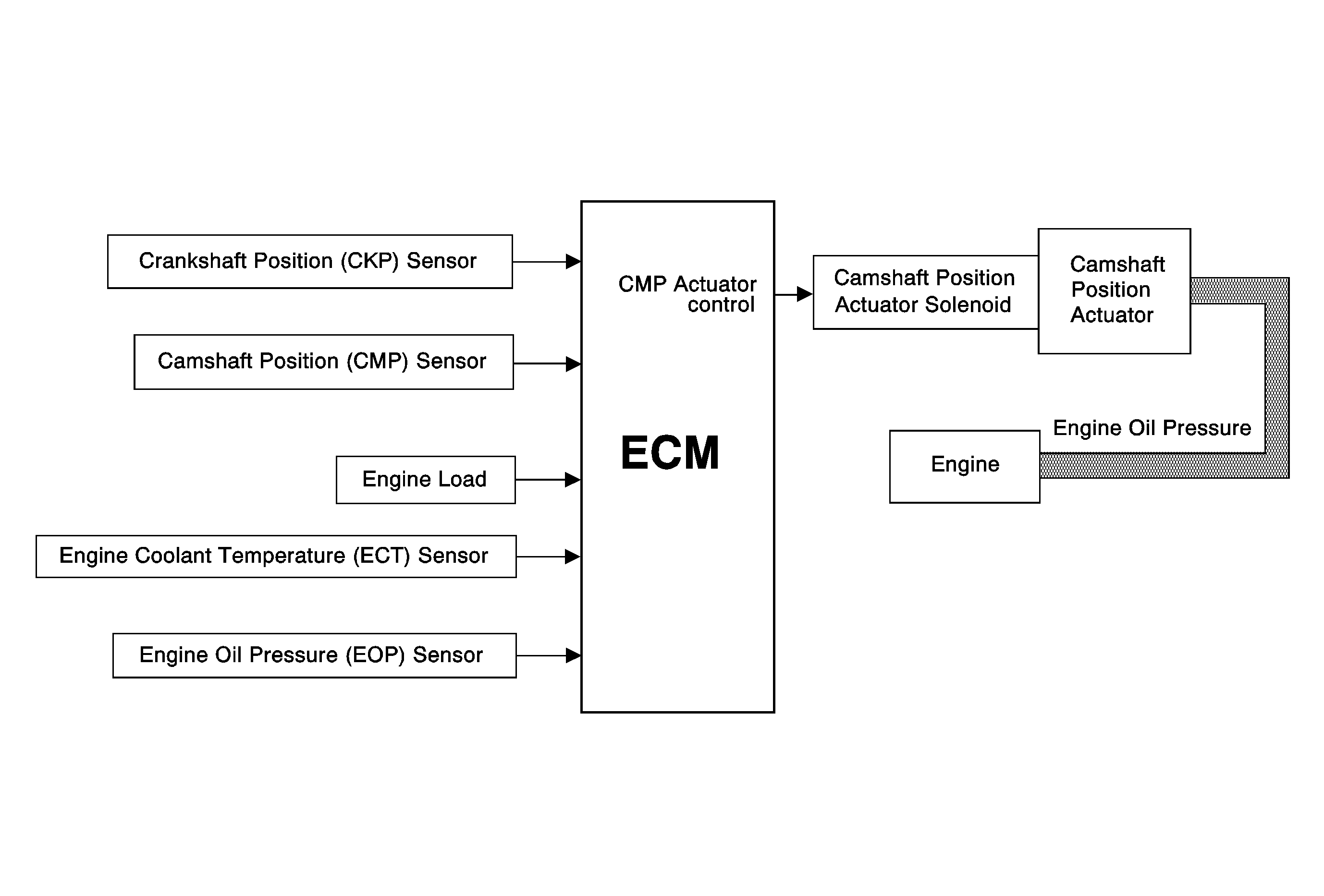Camshaft Position (CMP) Actuator System
The camshaft position (CMP) actuator system is used on both the intake and exhaust camshafts. The CMP actuator system is used for a variety of engine performance enhancements. These enhancements include lower emission output through exhaust gas recirculation
(EGR) control, a wider engine torque range, improved gas millage, and improved engine idle stability. The CMP actuator system accomplishes this by controlling the amount of intake and exhaust valve overlap.
CMP Actuator System Operation
The camshaft position (CMP) actuator system is controlled by the control module. The control module sends a pulse width modulated 12-volt signal to each CMP actuator solenoid to control the amount of engine oil flow to a camshaft actuator passage.
There are 2 different passages for oil to flow through, a passage for camshaft advance and a passage for camshaft retard. The camshaft actuator is attached to each camshaft and is hydraulically operated to change the angle of each camshaft relative to
crankshaft position (CKP). Engine oil pressure (EOP), viscosity, temperature, and engine oil level can affect camshaft actuator performance. The control module calculates the optimum camshaft position through the following inputs:
| • | Manifold absolute pressure (MAP) |
| • | Throttle position indicated angle |
| • | Barometric pressure (BARO) |
A locking pin keeps the CMP actuators in the parked position to avoid valve train noise upon engine start-up. The parked position is 0 degrees of camshaft actuation. The locking pin will release the actuator after the EOP is sufficient to overcome
the locking pin spring pressure. The exhaust CMP actuators also have return springs. The return springs are necessary to assist the CMP actuators to return to the parked position due to the rotational inertia of the valve train components upon engine shutdown.
The control module uses the following inputs before assuming control of the CMP actuator:
| • | Engine coolant temperature (ECT) |
| • | Closed loop fuel control |
| • | Engine oil temperature (EOT) |
| • | CMP actuator solenoid circuit state |
| • | Ignition 1 signal voltage |
CMP Actuator Solenoid Circuit Diagnostics
The control module monitors the control circuits of the camshaft position (CMP) actuator solenoid for electrical faults. The control module has the ability to determine if a control circuit is open, shorted high, and shorted low. If the control module
detects a fault with a CMP actuator solenoid circuit, a DTC will set.
CMP Actuator System Performance Diagnostics
The control module monitors the performance of the camshaft position (CMP) actuator system by monitoring the actual and desired position of the CMP sensor. If the difference between the actual and desired position is more than a calibrated angle for more
than a calibrated amount of time, a DTC will set.

Camshaft Position (CMP) Actuator System
The camshaft position (CMP) actuator system is an electro-hydraulic operated device used for a variety of engine performance and operational enhancements. These enhancements include lower emission output through exhaust gas dilution of the intake
charge in the combustion chamber, a broader engine torque range, and improved fuel economy. The CMP actuator system accomplishes this by changing the angle or timing of the camshaft relative to the crankshaft position. The CMP actuator simply allows earlier
or later intake and exhaust valve opening during the four stroke engine cycle. The CMP actuator cannot vary the duration of valve opening, or the valve lift.
During engine OFF, engine idling conditions, and engine shutdown, the camshaft actuator is held in the Park position. Internal to the CMP actuator assembly is a return spring and a locking pin. During non-phasing modes of the camshaft, the return
spring rotates the camshaft back to the Park position, and the locking pin retains the CMP actuator sprocket to the camshaft.
CMP Actuator System Operation
The camshaft position (CMP) actuator system is controlled by the engine control module (ECM). The ECM sends a signal to a CMP actuator solenoid in order to control the amount of engine oil flow to a Cam Actuator passage. The pressurized engine oil is sent
to unseat the locking pin, and to the vane and rotor assembly of the CMP actuator. There are 2 different passages for oil to flow through, a passage for cam advance and a passage for cam retard. The Cam Actuator is attached to a camshaft and is hydraulically
operated in order to change the angle of the camshaft relative to crankshaft position (CKP). Engine oil pressure (EOP), viscosity, temperature and engine oil level can have an adverse affect on Cam Actuator performance.

